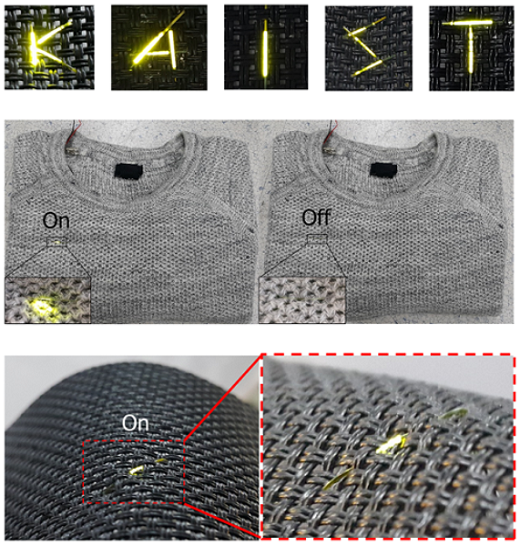Researchers from the Korea Advanced Institute of Science and Technology (KAIST) have succeeded in fabricating highly efficient organic light-emitting diodes (OLEDs) on ultra-narrow fibres thinner than a human hair. The team explained that the technology, which featured in Nano Letters last month, produces highly efficient, long-lasting OLEDs that could be woven into textiles and knitted clothes for producing wearable displays.

The new fibre-based OLEDs can be woven into knitted clothes to produce wearable displays. (Image: Kwon et al.)
According to the researchers, existing fibre-based wearable displays’ OLEDs demonstrate much lower performance compared to those fabricated on planar substrates, which limits their application. The KAIST team, led by Professor Kyung Cheol Choi from the School of Electrical Engineering and PhD candidate Seonil Kwon, therefore designed a structure of OLEDs compatible to fibre, and used a special dip-coating method in a 3D structure of fibres to develop efficient OLEDs designed to last a lifetime, with performance equivalent to those on planar substrates.
‘This simple, low-cost process opens a way to commercialise fibre-based wearable displays,’ commented Choi.
Exhibiting luminance and current efficiency values of over 10,000cd/m2 (candela/square meter) and 11cd/A (candela/ampere), the researchers identified that their solution-processed planar OLEDs can be applied to fibres without any reduction in performance.
The team also verified that the fibre OLEDs withstood tensile strains of up to 4.3 per cent while retaining more than 90 per cent of their current efficiency. In addition, the OLEDs could be fabricated on fibres with diameters ranging from 300µm down to 90µm, thinner than a human hair, which attests to the scalability of the proposed fabrication scheme. The fibres can be woven into textiles and knitted clothes without causing any problems, according to the researchers.
Due to the researchers’ process being carried out at relatively low temperatures – approximately 105⁰C – fibres vulnerable to high temperatures can also be used in this new fabrication scheme.
This work was funded by the Engineering Research Center of Excellence Program and the Nano-Material Technology Development Program by the National Research Foundation of Korea and the Ministry of Science and ICT of Korea.

